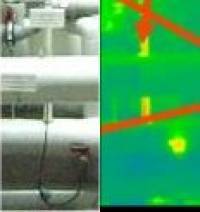This is an old revision of the document!
Table of Contents
Immediate measures
Space heating is used to replace heat losses to the outside. Some of these heat losses can easily be reduced - efficiently and at a low cost.
When it comes to hot water demand (which has a much lower energy requirement than room heating), the heat losses are mainly caused by the distribution system and storage. This problem can also often be solved quickly, efficiently, and cost-effectively.
Pipe insulation
In most countries, a minimum standard of pipe insulation has been required by law for a long time. Unfortunately, this requirement hasn't been enforced robustly enough, and the actual implementation has always been lower than the target value. You can find more information in our article Nuremberg case study: Thermographic inspection with reference to building services.
Showerhead
The energy demand for hot water makes up around 10% of total household consumption, which is often wasted. Therefore, it is worth looking into how hot water can be saved, such as by using a water-saving showerhead. The article water-saving - showerhead (in German) gives further information on this - the equipment is easy to obtain and replace.
Insulation of radiator niches
Another little-known, easily-implemented measure is the insulation of radiator cavities. In hot water-based heating systems, installing insulation behind the radiator's cavity has a significant energy-saving effect. Using a few millimetres or centimetres of insulation, such' minor interventions' do not influence radiator operation. However, thin layers are not recommended for walls, ceilings, or roofs, generally speaking. First of all, the insulation thickness is insufficient. Second, interior insulation should only be installed by a qualified professional after careful planning. You can find more information in our article interior insulation.
More insulation measures
Well-planned and executed insulation measures are always efficient. The best place for implementation is on the exterior of the building. Here is a link to some basic information on how insulation works.
Carefully planned and executed thermal protection measures, preferably on the outside of existing buildings, are significantly more effective and have a number of advantages:
- At the same time, in winter the temperatures of the interior surfaces of the building assembly are increased. This provides two advantages: thermal comfort is improved, and the tendency towards damp surfaces is greatly decreased.
- If an old heating system based on gas or fuel oil exists, then very little of this fuel will be consumed right away
- Due to the reduced heating load, the forward flow temperature necessary for the heating system is also reduced. This raises the efficiency of the heating system - which is particularly significant in the case of heat pump based heating systems; here the efficiency referred to as the annual COP depends greatly on the temperature that is required.
- If a new heating system is installed, then this can be smaller (and therefore more cost-effective) due to the lower heating load. This effect is particularly pronounced in the case of heat pumps.
- If energy for space heating becomes really scarce or extremely expensive, then the ability to adopt a more energy-conserving behaviour is even considerably improved with a better level of thermal protection. And, in the worst case, even without any heating it stays warm for longer, and in case of prolonged periods without energy it also won't be so excessively cold (on account of the internal heat gains). Here is a link about the basic principles in this regard: implementing thermal protection correctly.
Saving electricity
Frequently, the focus is not put on this aspect, although this is where considerable cost savings can be achieved on account of the high electricity prices. Appliances with a much better level of efficiency are available on the market; whenever first-time acquisition is already necessary in any case, it is usually especially worthwhile to choose an appliance that is more energy efficient, even though it might necessitate slightly higher investment. A whole range of further measures are available for reducing the electricity demand - this will have a considerably positive impact with regard to climate protection and consumption of fossil fuels, as fossil-based power plants can often be shut down if less electricity is consumed. Initial approaches can already be found in this Passipedia article: Optimisation of the electricity demand.

